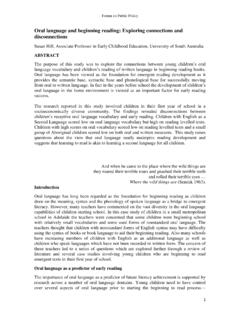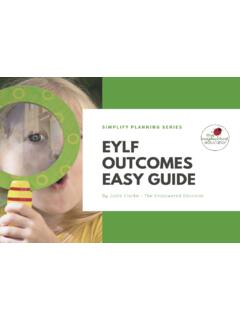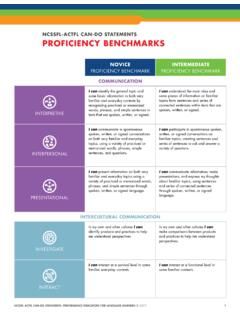Transcription of ERIK ERIKSON'S THEORY OF IDENTITY DEVELOPMENT
1 C H APT E ERIKSON'STHEORY OF IDENTITYDEVELOPMENTErik H. ERIKSON'S (1902-1994) THEORY reflects in part bis psychoanalytic training, but, it embraces society's influence and the social aspects of DEVELOPMENT to a much larger ex-refit than did Freud's. With little more than a German high school education, Erikson at-tended art schools and traveled in ltaly, apparently in search of 4is own IDENTITY . Erikson'slater writing popularized the concept of " IDENTITY ," and he applied it especially to the pe-riod of adolescence. After Erikson returned to Germany, where he studied art and preparedto teach art, he was offered a teaching position in a private school in Vienna that served thechildren of patients of Sigmund and Anna Freud. Peter Blos, a friend of Erikson from therime they attended the Gymnasium together, also worked as a teacher in the same schooland it was Blos's idea to offer Erikson the position. During bis tenure as a teacher, Eriksonwas invited to undergo psychoanalysis with Anna Freud, and during this process bis inter-est expanded from art and teaching to also include the study of psychoanalysis.
2 While inVienna, he also studied Montessori education, which later influenced bis psychoanalyticstudies, such as the organization of abjects in space. Erikson graduated from the ViennaPsychoanalytic lnstitute in 1933 as a lay analyst since he held no medical or academic de-grees. Later that year, he immigrated to the United States and became associated with theHarvard Psychological bas published extensively, bis best known and most widely read book beingChitdhood and Society, published in 1950 and revised in 1963. Of particular significance toan understanding of adolescence is bis ldentity: Youth and Crisis (1968). ERIKSON'S more re-cent book, The Life Cycle Compteted (1982), encompasses an integration of much of bis ear-lier work, but with the explicit purpose of exploring DEVELOPMENT by beginning with oldage and to make sense of the "completed life cycle." He also explained that the new orga-nization reflects bis view that, because aIl stages grow out of previous stages, tracing the an-tecedents backward would highlight these relationships.
3 The idea of IDENTITY formation basremained the focus of much of bis work and appears in other book titles, such as ldentity42-.!! ERIK ERIKSON'S THEORY OF IDENTITY DEVELOPMENTand the Life Cycle (1959). ln addition, he has examined the IDENTITY issue of historical fig-ures, such as Martin Luther (1962), Mahatma Gandhi (1969), and Thomas Jefferson. lnthese psycho-historical studies he is concerned with the IDENTITY crisis of each of these menas weIl as with the respective national IDENTITY issues at the cime of their most notable con-tributions. Revealing his basic philosophy, he maintains chat one cannot separate "the iden-city crisis in individuallife and contemporary crisis in historical DEVELOPMENT because thetwo help to define each other and are truly relative to each other" (Erikson, 1968: 23). Theward crisis, as Erikson uses it, is not just an emotional turmoil or emergency; it also has (asit does in Chinese), the meaning of "opportunity," an idea chat is essential to an under-standing of the ward crisis as Erikson sees it.
4 Erikson has also written about his own iden-tiry crisis as weIl as the philosophical and psychoanalytic foundation of the concept in "Au-tobiog;raphic Notes on the IDENTITY Crisis" (1970).ln his famous chapter, "Eight Stages of Man," Erikson (1950) modifies and expands theFreudian stages of psychosexual DEVELOPMENT by placing much greater emphasis on the so-cial context of DEVELOPMENT . Erikson also is the first persan who proposes a life-span theoryof DEVELOPMENT chat encompasses the entire life cycle. His modifications were inspired byanthropological findings and a concern with the social origins of these stages, which con-tribute to a shift from the sexual nature of man to a THEORY of psychosocial cote concept in this THEORY is the acquisition of an ego- IDENTITY , and the exploration ofidentity issues becomes the outstanding characteristic of adolescence. Although the specificquality of a person's IDENTITY differs from culture to culture, the accomplishment of this de-velopmental task has common elements in ail cultures.
5 The establishment of a crue sense ofa personal IDENTITY is the psychological connection berween childhood and adulthood. lnorder to acquire a strong and healthy ego- IDENTITY , the child musc receive consistent andmeaningful recognition for his or her achievements and develop according to the ePigenetic princip/e of deve/opment, borrowed from em-bryology, which states "chat anything chat grows has a ground plan, and chat out of thisground plan the parts arise, each part having its cime of special ascendancy, until ail partshave risen to form a functional whole" (Erikson, 1968: 92). Epigenesis, for Erikson (1982:28) involves much more chan a sequence of stages: "It also determines certain laws in thefundamental relations of the growing parts to each other.." Every element musc arise atthe appropriate cime; the failure to do so will jeopardize the DEVELOPMENT of "a successionof potentials for significant interaction" with significant others and the "mores that governthem." Unless normal DEVELOPMENT cakes place, the individual cannot grow inca a psycho-logically healthy persan.
6 Obviously, the significant others and the individual interact, sothe ongoing process is mutual and reciprocal. ln other words, the epigenic plan which arisesfrom within the human organism is supported (or interfered with) by social demands. It ba-sically identifies the developmental interaction between maturational advances and the so-cial expectations made upon the child. For example, at about age 2-3 the social demandplaced upon children to control elimination (an issue in the autonomy stage) dovetails withthe child's maturational ability to exercise the necessary sphincter contrai. Furthermore,every stage is related developmentally to every other stage, "whether in the form of an ear-lier condition or of a lacer consequence" (Erikson, 1982: 61).ln the epigenic model (Figure ), the basic ground plan of increasing psychosocialdifferentiation is depicted. The diagonal axis, beginning with "Trust Ys. Mistrust," shows44 Erik Erikson'J THEORY ofldentity DEVELOPMENT /Erik Erikson (1902-1994)the developmental sequence of the well-known eight stages of man.
7 Movement upwardalong the diagonal axis represents normal DEVELOPMENT and shows the successive differen-tiation of the original undifferentiated structure, and thus represents increasingly more ma-ture levels of functioning. This diagram demonstrates that:1. Each item of the vital personality is systematically related to aIl others; theyalldepend on the proper DEVELOPMENT in the proper sequence of each ~~-; ..~ uS c'" ~," .", ,~..~'~ '~=~ ~ ]~ ~~~~~ ~13~13~~~ ~f-4 1::: "'" ,9-< < ;]?;o8 r-- !:.--;.~ z ," 'C'~ u~ ," '"..~ o,a .c C;z; v 0 ""~ r5 ~~ ]& ~~13 '~[~E;s8b Z c .cd!9 ,g C \J:) J: cf-4 ~ ,g :2 0;:S "i 'c l a ~ tf-4 a ~~ ~~ ;.,07.;i]j"O.;'~o .cZ~=--",p,=-~U .>.VI ;;>8"" .~ ~' C uZ e::: 0 "tJ~0 <.: '~c 'c C c:>- >- -'P ~ ,g ~ 0 '\1 ~f-4 f-4", C ~.. '~~ -'P Of' ~1::: 1::: ~ ~ ~ ,& ~ :S 8 ~ 8 '~ ,~, ' -~ ~z .Ij ~ '~~ .E.;3 ~ o.!..0 '~.s ~@8~88 ~~~ ~~~~ ~ ~~ :i~~~~ 'f::.~'- ~'Cc: ;.,Q, >- ~c.'~f-4 --01 >- ~ E~,~ '" ~ 0 ~ ,g ~~ '~ '" ~ ~-:~ .Ij'" ~ ~ F:' ;.,Q, '" ~ ;acQ, ,g$.
8 9. '7 ..~<~P'P, ~~~ ,~~C ~80 ,-cd,~ ..~qj5 c cC '" ~oe C f-4 .-t'c ,g ~!:j 2" ~..~ .." t-' -R' -= -.'" .~~~~~ ~~ ~3~~~o'" >- -c~ ~ ,fi ,2?;o a ~"f-4 N ~,~C ,g0~~ :J E'; U \J ..:=t.:=a ~ ..:~~d~~13 <~'"..f-4]=- C '" ,~ 0 ~i ,~ t;; ~~~ e~ ~ '"~~~~13 ~~~= -~ > ~ = = -> >.. ~ 4546 Erik Erikton's THEORY of ldentity Deve/opment2. "Each item exists in some form before 'its' decisive and critical time normatifarrives" (Erikson, 1968: 93, 95). Thus, the horizontal and the vertical axesentries in Figure identify how earlier DEVELOPMENT contributes to identityin of the eight developmental stages is characterized by a conflict, and each conflictcontains the possibility of bipolar outcomes. Erikson suggests that the individual must ac-tually experience both sides of the conflict and must learn to subsume them into higher syn-thesis. This bipolar nature of the social crisis gives each stage its name, rather than the bodyzone that gives pleasure as in Freudian THEORY . If the conflict is worked out in a construc-tive, satisfactory manner, the syntonic or positive quality becomes the more dominant partof the ego and enhances further healthy DEVELOPMENT through the subsequent stages.
9 ForErikson, the growth of a positive self-concept is directif linked to the psychosocial stageresolution that constitutes the core of bis THEORY . However, if the conflict persists past itsrime, or is resolved unsatisfactorily, the dystonic or negative quality is incorporated into thepersonality structure. ln that case, the dystonic or negative attribute will interfere with fur-ther DEVELOPMENT and may manifest itself in impaired self-concept, adjustment problems,and possibly, (1982) substitutes the terms syntonic and dystonic for initially used terms posi-tive and negative, but they will be used interchangeably. The reader should bear in mind chatErikson emphasizes the necessity and healthiness of an individual actually having both syn-tonic and dystonic reactions depending on the situation. For example, a person walking thestreets in the clark of any major U .S. city willmQre likely avoid becoming the victim of anassault if he or she bas a healthy sense of mis trust and behaves accordingly.
10 Thus, as Erik-son states (1982: 80), "both syntonic and dystonic and both sympathic and antipathic po-tentials are necessary for human adaptation.."Each crisis or conflict is never completely solved but appears to be most pronounced atthe age at which it emerges. However, as in psychoanalytic THEORY , these stages occur in asequential order, as implied in ERIKSON'S use of the principle of epigenetic DEVELOPMENT . Ego" IDENTITY is never 'established' as an 'achievement,'" as something static or unchangeable,but is a "forever to-be-revised sense of realiry of the Self within social reality" (Erikson,1968: 24, 211). Although the identiry crisis is most pronounced during adolescence, andgives that age its stage name, IDENTITY issues remain a lifelong concern. A rede/inition ofone's ego- IDENTITY emerges quite commonly when majorrole changes occur, such as whencollege freshmen leave home and have to make their own decisions, often for the /irst issues that tend to renew IDENTITY concerns are: one's /irst job, marriage, parenthood,the death of one's parents, divorce, unemployment, serious illness, widowhood, and retire-ment.







